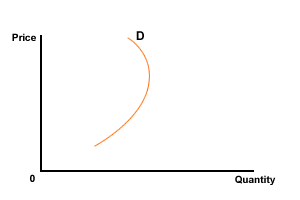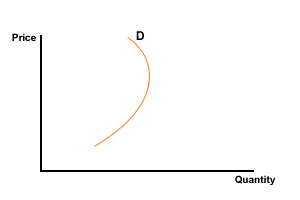Exceptions to the normal law of demand
We have assumed so far that demand curves slope downwards from left to right, and most of the time this is true. However, there are a few circumstances where it is possible for the demand curve to slope upwards to the right. This may be for the whole curve or, more likely, it may be over a certain price range, as shown in Figure 1. This is often termed a perverse or upward sloping demand curve.

Figure 1 Perverse demand curve
There are two particular types of goods where this may occur and they are called Giffen goods and Veblen goods. Let's look at the definitions of these.

Giffen good
A Giffen good is a good for which an increase in price results in an increase in demand for the good. It is an extreme inferior good and will have a perverse (i.e. upward sloping) demand curve.

Veblen good
A Veblen good (named after an American economist - Thorstein Bunde Veblen) is a good that has an upward-sloping demand curve. People buy more of the good because it is more expensive and therefore demand is higher when the price is higher.
Giffen goods
In some poor countries, the people often live on a basic diet of rice which is very cheap plus a few more expensive vegetables or some much more expensive meat or fish. In such societies, if the price of rice rises then the people may well decide to buy more in order to substitute it for the more expensive vegetables and meat. There has been an increase in demand in response to an increase in price. Sir Robert Giffen fist noticed this phenomenon. In the 19th century, he saw that the demand for potatoes increased in response to the rises in the price of potatoes caused by the great potato famines in Ireland. Hence products of this kind are known as Giffen goods. Examples of Giffen goods are difficult to find in richer countries.
Veblen goods
Products such as perfumes, expensive cars, jewellery, works of art and designer clothes may be regarded as Veblen goods. With these products, a rise in price is often interpreted by the consumer as an increase in quality or ostentation and so they may decide to buy more, thinking that they are buying a superior product. There may be psychological factors at work. The economist Veblen carried out research into this and concluded that the price of a product conveyed more than just value information for the consumer; it also represented status and exclusivity. These products which appear to experience rising demand with rising price are known as Veblen goods.
The demand curve for such goods will slope upwards from left to right.

Price expectations
It is also possible for goods where price expectations are critical to have perverse demand curves. This is because if people expect prices to increase further, then they may buy more now. In this case it appears that an increase in price has increased demand, but in reality this has come about because people expect prices to rise even further in the future.
